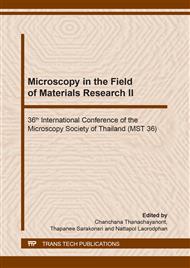[1]
Y. Mekonnen, A. Sundararajan, A. Sarwat, review of cathode and anode materials for lithium-ion batteries. Conf. Proc. - IEEE SOUTHEASTCON (2016).
DOI: 10.1109/secon.2016.7506639
Google Scholar
[2]
G. Zubi, R. Dufo-López, M. Carvalho, G. Pasaoglu, The lithium-ion battery: State of the art and future perspectives. Renew. Sustain. Energy Rev. 89 (2018) 292–308.
DOI: 10.1016/j.rser.2018.03.002
Google Scholar
[3]
X. Shen, et al. Research progress on silicon/carbon composite anode materials for lithium-ion battery. J. Energy Chem. 27 (2018) 1067–1090.
Google Scholar
[4]
E. Heidari, A. Kamyabi-Gol, M. Heydarzadeh Sohi, A. Ataie, Electrode Materials for Lithium Ion Batteries: A Review. J. Ultrafine Grained Nanostructured Mater. 51 (2018) 1–12.
Google Scholar
[5]
M. Brehob, R. Enbody, Y. Kwon, D. Tomanek, The potential of carbon-based memory systems. IEEE Comput. Soc. (1999) 110–114.
DOI: 10.1109/mtdt.1999.782691
Google Scholar
[6]
M. Fehse, E. Ventosa, Is TiO2 (B) the Future of Titanium-Based Battery Materials. Chempluschem 80 (2015) 785–795.
DOI: 10.1002/cplu.201500038
Google Scholar
[7]
M. Palacín, Recent advances in rechargeable battery materials: a chemist's perspective. Chem. Soc. Rev. 38 (2009) 2565.
DOI: 10.1039/b820555h
Google Scholar
[8]
S. Silviana, J. Wardhana, Silicon Conversion From Bamboo Leaf Silica By Magnesiothermic Reduction for Development of Li-ion Baterry Anode. MATEC Web Conf. 156 (2018) 1–4.
DOI: 10.1051/matecconf/201815605021
Google Scholar
[9]
I. Abdellaoui, M. Islam, T. Sakurai, S. Hamzaoui, K. Akimoto, Impurities removal process for high-purity silica production from diatomite. Hydrometallurgy 179 (2018) 207–214.
DOI: 10.1016/j.hydromet.2018.06.009
Google Scholar
[10]
H. Chew, B. Hou, X. Wang, S. Xia, Cracking mechanisms in lithiated silicon thin film electrodes. Int. J. Solids Struct. 51 (2014) 4176–4187.
DOI: 10.1016/j.ijsolstr.2014.08.008
Google Scholar
[11]
L. Cui, R. Ruffo, C. Chan, H. Peng, Y. Cui, Crystalline-Amorphous Core−Shell Silicon Nanowires for High Capacity and High Current Battery Electrodes. Nano Lett. 9 (2009) 491–495.
DOI: 10.1021/nl8036323
Google Scholar
[12]
W. Liao, D. Chen, Y. Zhang, J. Zhao, Binder-free TiO2 nanowires-C/Si/C 3D network composite as high performance anode for lithium ion battery. Mater. Lett. 209 (2017) 547–550.
DOI: 10.1016/j.matlet.2017.08.084
Google Scholar
[13]
N. Zhang, Y. Liu, J. Yang, S. Zhang, S. He, Preparation and characterization of nanosized multi-sphere Si-TiO2 based composites for lithium storage. Electrochim. Acta 212 (2016) 657–661.
DOI: 10.1016/j.electacta.2016.07.044
Google Scholar
[14]
D. Jia, X. Li, J. Huang, Bio-inspired sandwich-structured carbon/silicon/titanium-oxide nanofibers composite as an anode material for lithium-ion batteries. Compos. Part A Appl. Sci. Manuf. 101 (2017) 273–282.
DOI: 10.1016/j.compositesa.2017.06.028
Google Scholar
[15]
Z. Liu, et al. Nanostructured TiO2(B): the effect of size and shape on anode properties for Li-ion batteries. Prog. Nat. Sci. Mater. Int. 23 (2013) 235–244.
Google Scholar
[16]
Y. Xie, J. Song, P. Zhou, Y. Ling, Y. Wu, Controllable Synthesis of TiO2/Graphene Nanocomposites for Long Lifetime Lithium Storage: Nanoparticles vs. Nanolayers. Electrochim. Acta 210 (2016) 358–366.
DOI: 10.1016/j.electacta.2016.05.157
Google Scholar
[17]
R. Marchand, L. Brohan, M. Tournoux, TiO2 (B) a new form of titanium dioxide and the potassium octatitanate K2Ti8O17. Mater. Res. Bull. 15 (1980) 1129–1133.
DOI: 10.1016/0025-5408(80)90076-8
Google Scholar
[18]
A. Dylla, G. Henkelman, K.Stevenson, Lithium insertion in nanostructured TiO2(B) architectures. Acc. Chem. Res. 46 (2013) 1104–1112.
DOI: 10.1021/ar300176y
Google Scholar
[19]
J. Dahn, T. Zheng, Y. Liu, J. Xue, Mechanisms for Lithium Insertion in Carbonaceous Materials. Science. 270 (1995) 590–593.
DOI: 10.1126/science.270.5236.590
Google Scholar
[20]
Z. Wu, W. Ren, L. Xu, F. Li, H. Cheng, Doped Graphene Sheets As Anode Materials with Superhigh Rate and Large Capacity for Lithium Ion Batteries. ACS Nano 5 (2011) 5463–5471.
DOI: 10.1021/nn2006249
Google Scholar
[21]
M. Kim, H. Hwang, G. Park, H Lee,. Graphene-based composite electrodes for electrochemical energy storage devices: Recent progress and challenges. FlatChem 6 (2017) 48–76.
DOI: 10.1016/j.flatc.2017.08.002
Google Scholar
[22]
M. Madian, A. Eychmüller, L. Giebeler, Current Advances in TiO2-Based Nanostructure Electrodes for High Performance Lithium Ion Batteries. Batteries 4 (2018) 7.
DOI: 10.3390/batteries4010007
Google Scholar
[23]
X. Xin, X. Zhou, J. Wu, X. Yao, Z. Liu, Scalable Synthesis of TiO2/Graphene Nanostructured Composite with High-Rate Performance for Lithium Ion Batteries. ACS Nano 6 (2012) 11035–11043.
DOI: 10.1021/nn304725m
Google Scholar
[24]
Y. Cen, Q. Qin, R. Sisson, J. Liang, Effect of Particle Size and Surface Treatment on Si/Graphene Nanocomposite Lithium-Ion Battery Anodes. Electrochim. Acta. 251 (2017) 690–698.
DOI: 10.1016/j.electacta.2017.08.139
Google Scholar
[25]
Y. Chimupala, R. Drummond-Brydson, Hydrothermal Synthesis and Phase Formation Mechanism of TiO2(B) Nanorods via Alkali Metal Titanate Phase Transformation. Solid State Phenom. 283 (2018) 23–36.
DOI: 10.4028/www.scientific.net/ssp.283.23
Google Scholar
[26]
V. Laokawee, et al., Preparation and Characterization of Rice Husks-Derived Silicon-Tin/Nitrogen-Doped Reduced Graphene Oxide Nanocomposites as Anode Materials for Lithium-Ion Batteries. Solid State Phenom. 283 (2018) 46–54.
DOI: 10.4028/www.scientific.net/ssp.283.46
Google Scholar
[27]
N. Jarulertwathana, V. Laokawee, W. Susingrat, S.J. Hwang, T. Sarakonsri, Nano-structure tin/nitrogen-doped reduced graphene oxide composites as high capacity lithium-ion batteries anodes. J. Mater. Sci. Mater. Electron. 28 (2017) 18994–19002.
DOI: 10.1007/s10854-017-7853-y
Google Scholar
[28]
P. Półrolniczak, M. Walkowiak, Titanium dioxide high aspect ratio nanoparticle hydrothermal synthesis optimization. Open Chem. 13 (2015) 75–81.
DOI: 10.1515/chem-2015-0006
Google Scholar
[29]
C.A. Schneider, W.S. Rasband, K.W. Eliceiri, NIH Image to ImageJ: 25 years of image analysis. Nature methods 9 (2012) 671-675.
DOI: 10.1038/nmeth.2089
Google Scholar


